

Visual Cloud Development Platform Acquired by VMware. News Visual Cloud Development Platform Acquired by VMware San Francisco-based Wavemaker, provider of a graphical development platform for Java-based Web and cloud applications, based on the Spring development enviornment, will be acquired by VMware, the company announced recently.
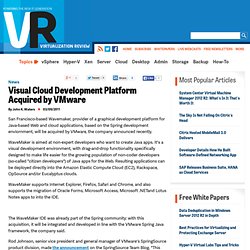
Wi-Fi. Wi-Fi, also spelled Wifi or WiFi, is a technology that allows an electronic device to exchange data or connect to the internet wirelessly using 2.4 GHz UHF and 5 GHz SHF radio waves.
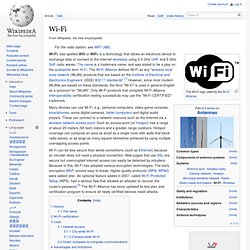
The name is a trademark name, and was stated to be a play on the audiophile term Hi-Fi. The Wi-Fi Alliance defines Wi-Fi as any "wireless local area network (WLAN) products that are based on the Institute of Electrical and Electronics Engineers' (IEEE) 802.11 standards".[1] However, since most modern WLANs are based on these standards, the term "Wi-Fi" is used in general English as a synonym for "WLAN".
Only Wi-Fi products that complete Wi-Fi Alliance interoperability certification testing successfully may use the "Wi-Fi CERTIFIED" trademark. Depiction of a device sending information wirelessly to another device, both connected to the local network, in order to print a document. Twisted Radio Waves Could Expand Mobile-Phone Bandwidth by a Factor of 9. Mobile ad hoc network. Java Virtual Machine. Overview of a Java virtual machine (JVM) architecture.
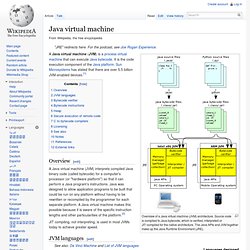
Source code is compiled to Java bytecode, which is verified, interpreted or JIT-compiled for the native architecture. The Java APIs and JVM together make up the Java Runtime Environment (JRE). WebKit. WebKit is available under a BSD-form license[11] with the exception of the WebCore and JavaScriptCore components, which are available under the GNU Lesser General Public License.
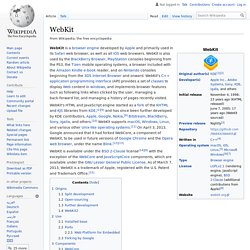
As of March 7, 2013, WebKit is a trademark of Apple, registered with the U.S. HTML5. HTML5 is a markup language used for structuring and presenting content for the World Wide Web and a core technology of the Internet. It is the fifth revision of the HTML standard (created in 1990 and standardized as HTML 4 as of 1997)[2] and, as of December 2012[update], is a candidate recommendation of the World Wide Web Consortium (W3C).[3] Its core aims have been to improve the language with support for the latest multimedia while keeping it easily readable by humans and consistently understood by computers and devices (web browsers, parsers, etc.).
HTML5 is intended to subsume not only HTML 4, but also XHTML 1 and DOM Level 2 HTML.[2] History[edit] The Web Hypertext Application Technology Working Group (WHATWG) began work on the new standard in 2004. At that time, HTML 4.01 had not been updated since 2000,[8] and the World Wide Web Consortium (W3C) was focusing future developments on XHTML 2.0. While HTML5 is often compared to Flash, the two technologies are very different. WebSockets. WebSocket is a protocol providing full-duplex communications channels over a single TCP connection.
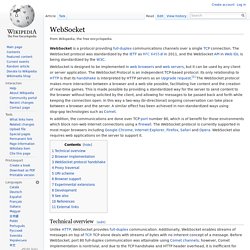
The WebSocket protocol was standardized by the IETF as RFC 6455 in 2011, and the WebSocket API in Web IDL is being standardized by the W3C.
WebGL. Design[edit] Like OpenGL ES 2.0, WebGL does not have the fixed-function APIs introduced in OpenGL 1.0 and deprecated in OpenGL 3.0.
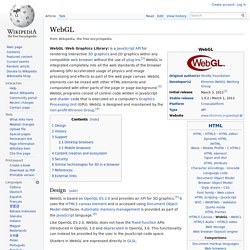
This functionality can instead be provided by the user in the JavaScript code space. Shaders in WebGL are expressed directly in GLSL. Google Chrome 9 review - reviews for IT Leaders - Computing. Google is showing no let-up in adding advanced features with the release of the Chrome version 9 web browser.
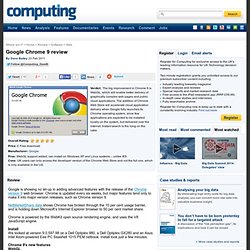
Chrome is updated every six weeks, but major features tend only to make it into major version releases, such as Chrome version 9. NetMarketShare data shows Chrome has broken through the 10 per cent usage barrier, and is holding down Microsoft’s Internet Explorer browser to 50 per cent market share. Chrome is powered by the WebKit open source rendering engine, and uses the V8 JavaScript engine. InstallWe looked at version 9.0.597.98 on a Dell Optiplex 980, a Dell Optiplex GX280 and an Asus Intel Atom-powered Eee PC Seashell 1015 PEM netbook. Install took just a few minutes.Chrome 9's new featuresWebGLThe biggest feature in Chrome 9 is WebGL graphics support, which does not use browser plug-ins, which can be hard to use and update. BitTorrent (protocol) Programmer Bram Cohen, a former University at Buffalo graduate student in Computer Science,[4] designed the protocol in April 2001 and released the first available version on July 2, 2001,[5] and the final version in 2008.[6] BitTorrent clients are available for a variety of computing platforms and operating systems including an official client released by Bittorrent, Inc.

As of 2009, BitTorrent reportedly had about the same number of active users online as viewers of YouTube and Facebook combined.[7][8] As of January 2012[update], BitTorrent is utilized by 150 million active users (according to BitTorrent, Inc.). Based on this figure, the total number of monthly BitTorrent users can be estimated at more than a quarter of a billion.[9]